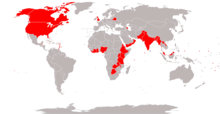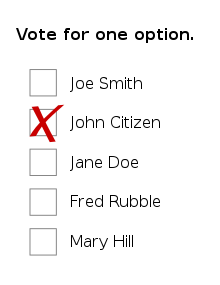
Back الفوز للأكثر أصواتا Arabic Escrutiniu mayoritariu uninominal AST Асноўнае галасаваньне з адным пераможцам BE-X-OLD फर्स्ट पास्ट द पोस्ट Bihari ফার্স্ট-পাস্ট-দ্য-পোস্ট ভোটদান Bengali/Bangla Escrutini uninominal majoritari Catalan System etholiadol 'y cyntaf i'r felin' Welsh Escrutinio mayoritario uninominal Spanish رأیگیری نخستگزینی Persian Scrutin uninominal majoritaire à un tour French
This article has an unclear citation style. (July 2024) |
It has been suggested that this article should be split into a new article titled Single-member district. (discuss) (September 2024) |
| A joint Politics and Economics series |
| Social choice and electoral systems |
|---|
 |
|
|

First-preference plurality (FPP)—often shortened simply to plurality—is a single-winner voting rule. Voters typically mark one candidate as their favorite, and the candidate with the largest number of first-preference marks (a plurality) is elected, regardless of whether they have over half of all votes (a majority). It is sometimes called first-past-the-post in reference to gambling on horse races (where bettors would guess which horse they thought would be first past the finishing post).[1][2][3] In social choice, FPP is generally treated as a degenerate variant of ranked voting, where voters rank the candidates, but only the first preference matters. As a result, FPP is usually implemented with a choose-one ballot, where voters place a single bubble next to their favorite candidate.
FPP has been used to elect the British House of Commons since the Middle Ages.[4] Throughout the 20th century, many countries that previously used FPP have abandoned it in favor of other electoral systems, including the former British colonies of Australia and New Zealand.
Despite its simplicity and long history, FPP has been widely criticized and is generally unpopular with electoral reformers, political scientists, and social choice theorists. Social choice theorists have criticized the rule for being highly vulnerable to spoiler effects, violating the majority-rule principle,[5][6] promoting extremism via center squeeze,[5] and reducing electoral competition via Duverger's law. These issues have led to various calls to replace FPP in single-winner elections with rules based on multi-round plurality-rules, majority-rules, or rated voting rules, and also to proposals replacing single-member districts in legislatures with rules based on proportional representation.
Most U.S. states still officially retain FPP for most elections. However, the combination of partisan primaries with the two-party system mean the country has effectively used a variation on the two-round system since the 1970s, where the first round selects two major contenders who go on to receive the overwhelming majority of votes.[7][8][9]

- ^ "First-past-the-post: a rogue's practice?". On Elections. 31 July 2018. Retrieved 9 September 2024.
- ^ "First past the post". nzhistory.govt.nz. Ministry for Culture and Heritage. 13 January 2016. Archived from the original on 24 May 2022. Retrieved 25 May 2022.
- ^ "First Past the Post and Alternative Vote explained". gov.uk. 6 September 2010. Archived from the original on 18 January 2024. Retrieved 13 July 2024.
- ^ "The Boundaries Review is a chance to bring back multi-member constituencies". 26 September 2016.
- ^ a b Merrill, Samuel (1985). "A statistical model for Condorcet efficiency based on simulation under spatial model assumptions". Public Choice. 47 (2): 389–403. doi:10.1007/bf00127534. ISSN 0048-5829.
the 'squeeze effect' that tends to reduce Condorcet efficiency if the relative dispersion (RD) of candidates is low. This effect is particularly strong for the plurality, runoff, and Hare systems, for which the garnering of first-place votes in a large field is essential to winning
- ^ Merrill, Samuel (1984). "A Comparison of Efficiency of Multicandidate Electoral Systems". American Journal of Political Science. 28 (1): 23–48. doi:10.2307/2110786. ISSN 0092-5853. JSTOR 2110786.
However, squeezed by surrounding opponents, a centrist candidate may receive few first-place votes and be eliminated under Hare.
- ^ Santucci, Jack; Shugart, Matthew; Latner, Michael S. (16 October 2023). "Toward a Different Kind of Party Government". Protect Democracy. Archived from the original on 16 July 2024. Retrieved 16 July 2024.
Finally, we should not discount the role of primaries. When we look at the range of countries with first-past-the-post (FPTP) elections (given no primaries), none with an assembly larger than Jamaica's (63) has a strict two-party system. These countries include the United Kingdom and Canada (where multiparty competition is in fact nationwide). Whether the U.S. should be called 'FPTP' itself is dubious, and not only because some states (e.g. Georgia) hold runoffs or use the alternative vote (e.g. Maine). Rather, the U.S. has an unusual two-round system in which the first round winnows the field. This usually is at the intraparty level, although sometimes it is without regard to party (e.g. in Alaska and California).
- ^ Gallagher, Michael; Mitchell, Paul (15 September 2005). "The American Electoral System". The Politics of Electoral Systems. OUP Oxford. p. 192. ISBN 978-0-19-153151-4.
American elections become a two-round run-off system with a delay of several months between the rounds.
- ^ Bowler, Shaun; Grofman, Bernard; Blais, André (2009), "The United States: A Case of Duvergerian Equilibrium", Duverger's Law of Plurality Voting: The Logic of Party Competition in Canada, India, the United Kingdom and the United States, New York, NY: Springer, pp. 135–146, doi:10.1007/978-0-387-09720-6_9, ISBN 978-0-387-09720-6, retrieved 31 August 2024,
In effect, the primary system means that the USA has a two-round runoff system of elections.